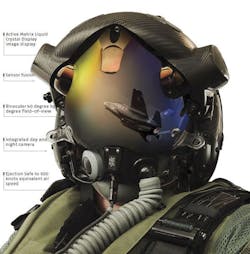F-35 JPO halts development of BAE Systems alternate helmet, focuses on Rockwell Collins Elbit Systems G2 helmet
FORT WORTH, Texas, 13 Oct. 2013. The F-35 Joint Program Office (JPO) officials have decided to halt development of the alternate F-35 helmet from BAE Systems and focus exclusively on maturing the Rockwell Collins Elbit Systems of America Vision Systems Generation 2 (Gen 2) helmet currently in training and testing.
The F-35 program, of which Lockheed Martin [NYSE:LMT] is prime contractor, will recoup approximately $45 million originally allocated for the development of the alternate helmet. BAE Systems engineers began developing the alternate helmet in September 2011, after program and industry officials acknowledged technical issues with the principal helmet system. The dual-path development plan was established to ensure viable combat capability was available when needed, and as a risk-management strategy in the event maturity issues facing the Gen 2 helmet could not be resolved.
“The government's decision to proceed exclusively with the principal helmet is indicative of their confidence in the helmet's performance and the successful resolution of previously identified technical challenges,” says Lorraine Martin, Lockheed Martin executive vice president and general manager of the F-35 Lightning II Program in Bethesda, Md. “To date, more than 100 F-35 pilots have flown more than 6,000 flights and 10,000 hours with the helmet, and their feedback has been very positive. Lockheed Martin and its suppliers will continue to focus on developing and delivering the helmet's unprecedented capabilities to the warfighter in support of the services’ declaration of Initial Operating Capability.”
The F-35’s Helmet Mounted Display Systems are designed to provide pilots with unprecedented situational awareness. The information pilots require to complete their missions, day or night and in any weather, is projected on the helmet’s visor. The F-35’s Distributed Aperture System streams real-time imagery from six infrared cameras mounted around the aircraft to the helmet.
The program will introduce a Gen 3 helmet featuring an improved night-vision camera, new liquid crystal displays (LCDs), automated alignment, and software enhancements beginning with aircraft in Low Rate Initial Production lot 7.
The F-35 Lightning II is a 5th generation fighter, combining advanced stealth with fighter speed and agility, fully fused sensor information, network-enabled operations and advanced sustainment. Three distinct variants of the F-35 will replace the A-10 and F-16 for the U.S. Air Force, the F/A-18 for the U.S. Navy, the F/A-18 and AV-B Harrier for the U.S. Marine Corps, and a variety of fighters for at least 10 other countries.

Courtney Howard | Executive Editor
Courtney, as executive editor, enjoys writing about all things electronics and avionics in PennWell’s burgeoning Aerospace and Defense Group, which encompasses Military & Aerospace Electronics, Avionics Intelligence, the Avionics Europe conference, and much more. She’s also a self-proclaimed social-media maven, mil-aero nerd, and avid avionics geek. Connect with Courtney at [email protected], @coho on Twitter, and on LinkedIn.

